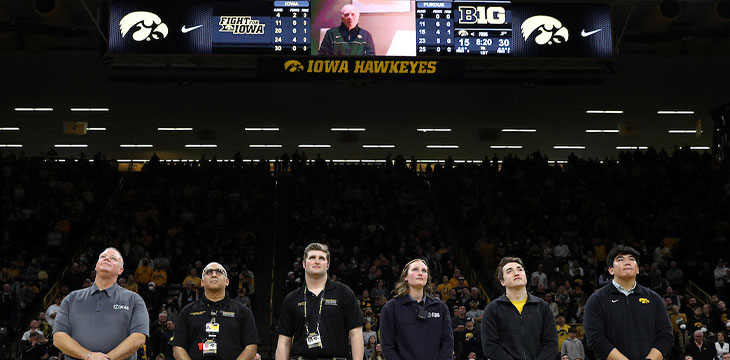Terrapin Fan Funds New AEDs After Cardiac Emergency at Iowa Basketball Game
 PHOTO: STAN GOLDSTEIN
Azeemuddin Ahmed (00MD, 10MBA) and Stan Goldstein pose for a photo at University of Iowa Hospitals & Clinics.
PHOTO: STAN GOLDSTEIN
Azeemuddin Ahmed (00MD, 10MBA) and Stan Goldstein pose for a photo at University of Iowa Hospitals & Clinics.
Stan Goldstein says basketball saved his life.
A University of Maryland season ticketholder and donor, Goldstein attends nearly every game each season, including away games. That’s how he found himself in Iowa City on Jan. 3.
Goldstein visited Hamburg Inn No. 2 with a few Maryland staff earlier that day, enjoying pie shakes before watching his team play Iowa at Carver-Hawkeye Arena. Maryland was up by four points just before the half, but a turnover by the Terps sent his heart rate climbing with .7 seconds on the clock. Suddenly, Goldstein hit the floor.
“Everything kind of got a little bit wavey … and turned a white, gray. I couldn’t see anything. That’s all I remember. Then, I was out,” he says.
Within 30 seconds, Azeemuddin Ahmed (00MD, 10MBA), an emergency medicine physician with University of Iowa Health Care, UI professor, and medical director at Kinnick Stadium and Carver-Hawkeye Arena, rushed into action. He, members of his team, and first-responders started CPR and hooked Goldstein up to an automated external defibrillator (AED). They shocked Goldstein twice, restarting his heart, before moving him to UI Hospitals & Clinics for more intensive care. He was discharged a week later after an Implantable Cardioverter Defibrillator was installed in his chest.
Goldstein recognized his outcome could have been much different had he not been at a game when his episode hit. Ahmed says aggressive CPR and AED use was vital. “In Stan’s situation we didn’t have the immediate full weight of the hospital behind us or a cardiologist―it was a small group of people doing CPR and using an AED,” he says. “Every single person has the opportunity to help save a life when using them.”
That’s a big reason why Goldstein decided to make a $12,000 donation to fund additional AEDs at Iowa’s athletic venues. Ahmed and his team carry AEDs with them during games, but many of the compact, easy-to-use machines are installed for public access throughout the arena and stadium.
Ahmed says his team responds to dozens of medical emergencies each year and at least one annually is a cardiac arrest. This year, his team has responded to three cardiac arrests—all with good outcomes—thanks to early, aggressive CPR and defibrillator use.
“When you get this many people together often, [a cardiac emergency] is going to happen,” says Ahmed. “So, when it does, we hope to rise to the occasion like we did this time, knowing we have state-of-the-art equipment funded by the Iowa athletic department and also a very grateful patient.”
 PHOTO: HAWKEYESPORTS.COM
Emergency responders who helped save Stan Goldstein’s life were honored during the Iowa vs. Purdue men’s basketball game at Carver-Hawkeye Arena.
PHOTO: HAWKEYESPORTS.COM
Emergency responders who helped save Stan Goldstein’s life were honored during the Iowa vs. Purdue men’s basketball game at Carver-Hawkeye Arena.
Goldstein says the care and compassion he received at Iowa was spectacular. He cites Ahmed, who spent over an hour with him in his hospital room late one evening explaining exactly what happened inside Carver-Hawkeye Arena. Goldstein also received a handwritten card from the nurses who cared for him after he returned home, several phone calls from Iowa men’s basketball coach Fran McCaffery, and an opportunity to acknowledge EMTs during a later Iowa game against Purdue.
“All of these things were just so shocking to me. I’m from Brooklyn originally. New Yorkers are not known for their hospitality,” says Goldstein. “It really left a mark that will never go away and feelings that will never go away.”
His allegiance remains with the Terps, but Goldstein admits he has a newfound fondness for the Hawkeyes.
“Iowa is my second favorite team in the Big Ten. No question about it,” he says.
